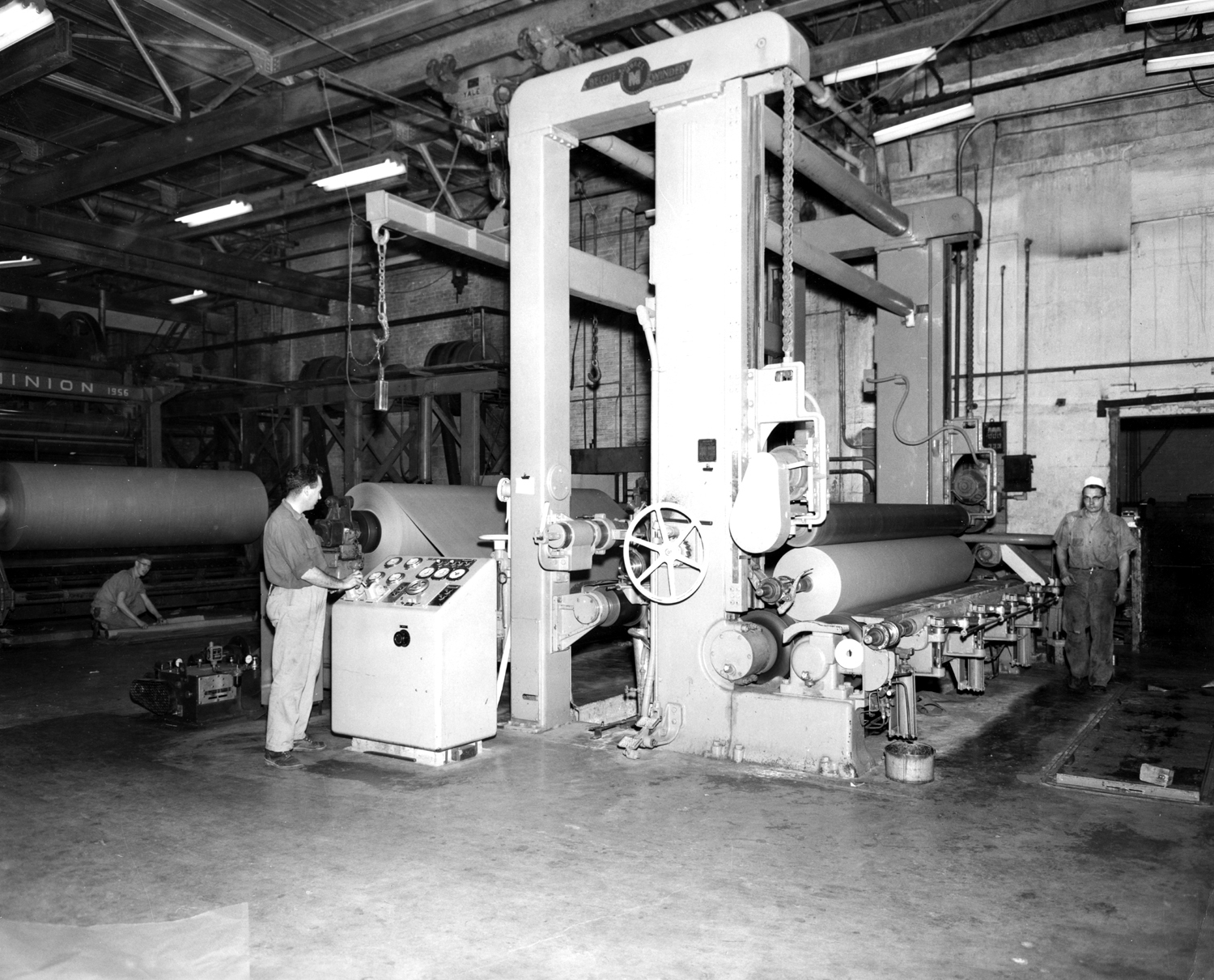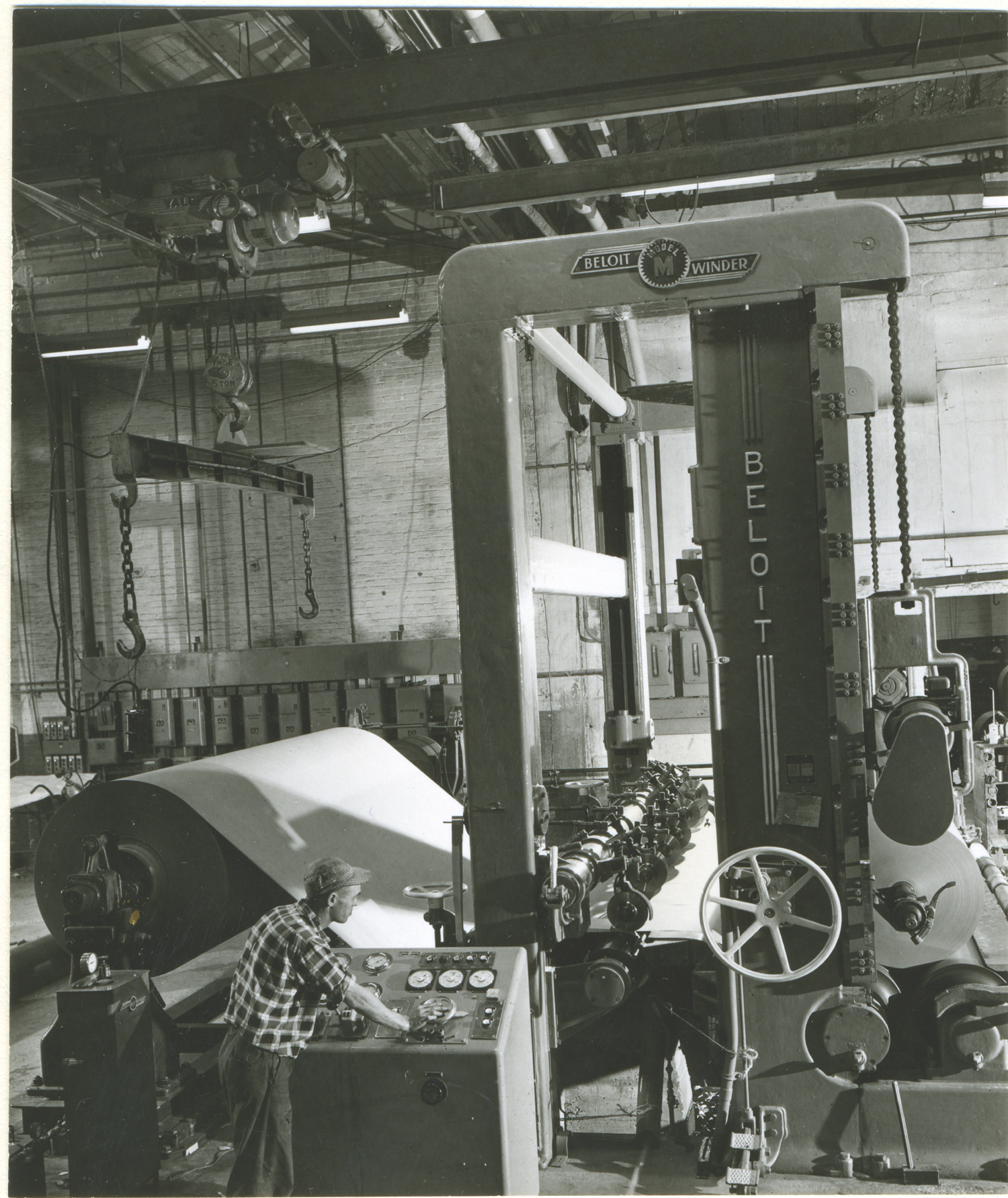During the spring of 1959, Bruce Valdock and his brother Linton were passing through Dryden when their car broke down. As a result of the mechanical breakdown, they were forced to spend some time in Dryden. While talking to other people, Bruce learned that the Dryden Paper Company was hiring new workers.
The next morning, Bruce dropped by the mill and was told that the company was in the process of rebuilding the No 4 paper machine and that he could start working immediately if he had a pair of safety work boots. As Bruce did not have any safety boots, he spent the rest of the day tending to errands and shopping for new work boots.
The next day, while wearing his new safety boots, Bruce reported to the mill to start his new job. He was escorted to a building showing him where the construction was taking place. There was a hole in the cement floor with markings around it outlining where the new rewinder for the No. 4 paper machine was to be built. (A rewinder is a machine that cuts a huge roll of wound up paper into more manageable rolls). Bruce was given a jackhammer and told to enlarge the hole around the markings on the cement floor. The hole that he was to dig was to be five or six feet deep to accommodate the supportive machinery, piping and cabling that would go underneath the new rewinder. Bruce, weighing only 139 pounds, felt overwhelmed with the jack hammer as he had trouble holding the machine even when it was not in operation. That first day of work, while Bruce used the jackhammer, others were shoveling cement and hauling large cement blocks with manual wheelbarrels. He worked a full twelve hours and was totally exhausted by the end of the day.
During the rest of the summer of 1959, Bruce along with his co-workers spent 12 hour days and worked 7 days a week doing heavy manual work on various aspects of the paper machine No 4 rebuild.
Pictured here is the Number 4 rewinder. Use the scroll bar to see the entire image

After the construction on the Number four rewinder, Bruce worked for seventeen years on the number two,three and four paper machines.
Bruce started as a broke hustler. It was the responsibility of the broke hustler to cut with a large knife any defective or below grade paper. Once the paper was cut into smaller sizes the paper was put back into the beater. The beater was a large vessel with paddles that would beat the stock to the required consistency. After the beater the stock went back to the mixing room where additives and chemicals were added to the solution. From there, the stock went back into the paper machines.
It must also be noted that substandard paper was also donated to local churches and charities to use as scrap paper, and as well, to the Dryden Day Care for children to use as colouring paper.
After broke hustler Bruce moved on to the 5th hand. He adds that the 5th hand was one of the hardest working employees. After the correctly sized rolls of paper were taken off the rewinder, it was the task of 5th hand to split the individual rolls apart and weigh them. Each roll of paper could weigh 800 pounds or more. Along with the weight, the worker determined the width and grade of paper. This record keeping was done so that every roll of paper could be traced back to its production. Finally, the 5th hand would stencil the customer's name on the end of the roll as well as the surface of the roll. At times, and according to customer specifications, tags identifying the customer were placed on the cores of the rolls, on the face of the roll and on both ends of the roll. When this was the requirement, the 5th hand found himself rushing to complete the order.
Advancing from the 5th hand, was the 4th hand. It was his duty to set up the cores that the paper was wound up on. By setting the cores in the correct spot, different widths of paper would be cut.
From 4th hand, one moved on to a 3rd hand winderman. Using a hoist, the winderman moved the large roll of paper off the paper machine and onto the rewinder. At this point the roll of paper was wound around a heavy steel roll that was in excess of ten feet in length. The weight of this roll was more than several tons. On the rewinder there are slitters that would cut the large roll of paper into sizes specified by the customer. For example, a typical order of paper might be 100 rolls of thirty-six inch width paper and 100 rolls of 44 inch width paper. As the large roll of paper went through the rewinder the slitters were set to cut the large roll of paper into the required widths.
The 3rd hand winderman along with the 4th hand and 5th hand would thread the large roll of paper through the rolls under the slitters and onto the cardboard cores. Once the paper was wrapped correctly, the slitters were engaged and then the rewinder was started slowly. If everything was going correctly the large roll of paper went through the rolls, was cut to correct width by the slitters and was then wrapped around the cardboard cores. The rewinder started slowly and the speed increased until the rolls in the rewinder would be turning at hundereds of revolutions per minute. If a slight tear occurred while the rollers were turning rapidly large amounts of paper would be torn and scatterd everywhere.
The man in the second position was called the back tender. He was responsible for the dry end of the paper machine. His main job was to build a good solid reel of saleable paper. The back tender had the option of running it through the size press and through two different calendar stacks as the customers specifications warranted.
The person in the first position was the machine tender. He was responsible for the wet end of the paper machine. His job was to take the pulp sent from the mixing floor and run it through the head box and then the Fourdrinier wire and finally the press felts.
It was the responsibility of each worker to know and be able to do the job of the worker ahead. Each successive worker had more responsibility and was thus better financially remunerated.
Pictured here is a roll of paper before it is resized by the rewinder

Here is a picture of the rewinder. Notice the slitters cutting the paper. At the left top is the bracket and chains used by the hoist hoist to move the reel of paper from the paper machine to the rewinder. The job transporting the roll of paper from the paper machine to the rewinder belonged to the 3rd hand rewinder

Another picture of the rewinder. Notice the large amount of broken paper on the floor. The broke hustler is in the process of taking an armfull of broken paper to put back in the beater.
